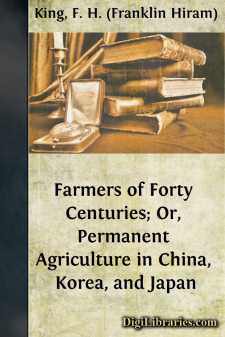Categories
- Antiques & Collectibles 13
- Architecture 36
- Art 48
- Bibles 22
- Biography & Autobiography 813
- Body, Mind & Spirit 142
- Business & Economics 28
- Children's Books 15
- Children's Fiction 12
- Computers 4
- Cooking 94
- Crafts & Hobbies 4
- Drama 346
- Education 46
- Family & Relationships 57
- Fiction 11828
- Games 19
- Gardening 17
- Health & Fitness 34
- History 1377
- House & Home 1
- Humor 147
- Juvenile Fiction 1873
- Juvenile Nonfiction 202
- Language Arts & Disciplines 88
- Law 16
- Literary Collections 686
- Literary Criticism 179
- Mathematics 13
- Medical 41
- Music 40
- Nature 179
- Non-Classifiable 1768
- Performing Arts 7
- Periodicals 1453
- Philosophy 64
- Photography 2
- Poetry 896
- Political Science 203
- Psychology 42
- Reference 154
- Religion 513
- Science 126
- Self-Help 84
- Social Science 81
- Sports & Recreation 34
- Study Aids 3
- Technology & Engineering 59
- Transportation 23
- Travel 463
- True Crime 29
Farmers of Forty Centuries; Or, Permanent Agriculture in China, Korea, and Japan
Description:
Excerpt
A word of introduction is needed to place the reader at the best view point from which to consider what is said in the following pages regarding the agricultural practices and customs of China, Korea and Japan. It should be borne in mind that the great factors which today characterize, dominate and determine the agricultural and other industrial operations of western nations were physical impossibilities to them one hundred years ago, and until then had been so to all people.
It should be observed, too, that the United States as yet is a nation of but few people widely scattered over a broad virgin land with more than twenty acres to the support of every man, woman and child, while the people whose practices are to be considered are toiling in fields tilled more than three thousand years and who have scarcely more than two acres per capita,* more than one-half of which is uncultivable mountain land.
*[Footnote: This figure was wrongly stated in the first edition as one acre, owing to a mistake in confusing the area of cultivated land with total area.]
Again, the great movement of cargoes of feeding stuffs and mineral fertilizers to western Europe and to the eastern United States began less than a century ago and has never been possible as a means of maintaining soil fertility in China, Korea or Japan, nor can it be continued indefinitely in either Europe or America. These importations are for the time making tolerable the waste of plant food materials through our modern systems of sewage disposal and other faulty practices; but the Mongolian races have held all such wastes, both urban and rural, and many others which we ignore, sacred to agriculture, applying them to their fields.
We are to consider some of the practices of a virile race of some five hundred millions of people who have an unimpaired inheritance moving with the momentum acquired through four thousand years; a people morally and intellectually strong, mechanically capable, who are awakening to a utilization of all the possibilities which science and invention during recent years have brought to western nations; and a people who have long dearly loved peace but who can and will fight in self defense if compelled to do so.
We had long desired to stand face to face with Chinese and Japanese farmers; to walk through their fields and to learn by seeing some of their methods, appliances and practices which centuries of stress and experience have led these oldest farmers in the world to adopt. We desired to learn how it is possible, after twenty and perhaps thirty or even forty centuries, for their soils to be made to produce sufficiently for the maintenance of such dense populations as are living now in these three countries. We have now had this opportunity and almost every day we were instructed, surprised and amazed at the conditions and practices which confronted us whichever way we turned; instructed in the ways and extent to which these nations for centuries have been and are conserving and utilizing their natural resources, surprised at the magnitude of the returns they are getting from their fields, and amazed at the amount of efficient human labor cheerfully given for a daily wage of five cents and their food, or for fifteen cents, United States currency, without food.
The three main islands of Japan in 1907 had a population of 46,977,003 maintained on 20,000 square miles of cultivated field. This is at the rate of more than three people to each acre, and of 2,349 to each square mile; and yet the total agricultural imports into Japan in 1907 exceeded the agricultural exports by less than one dollar per capita....


